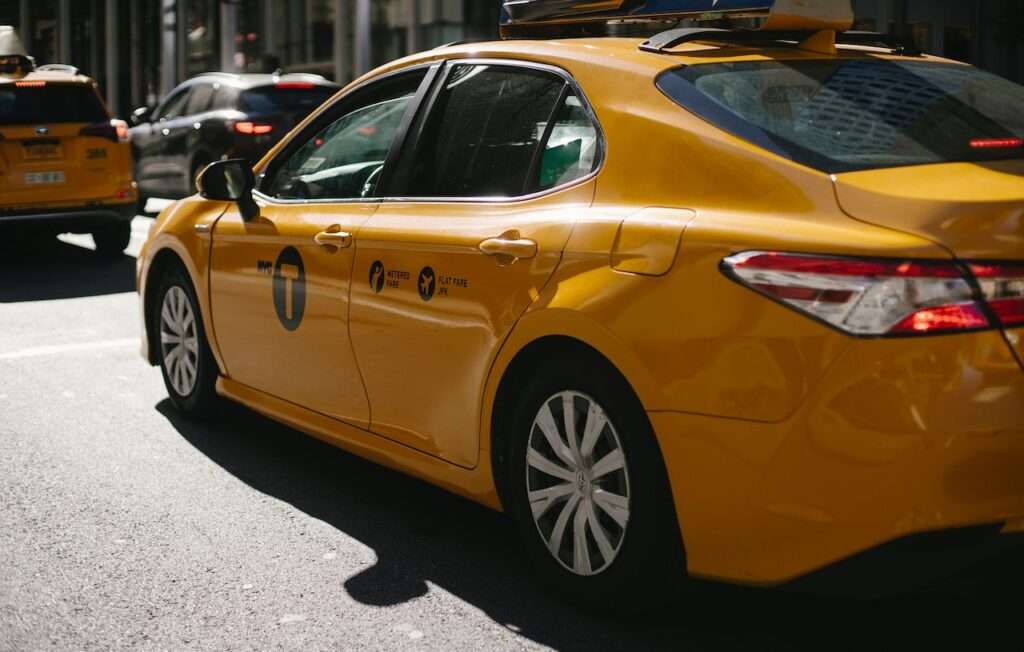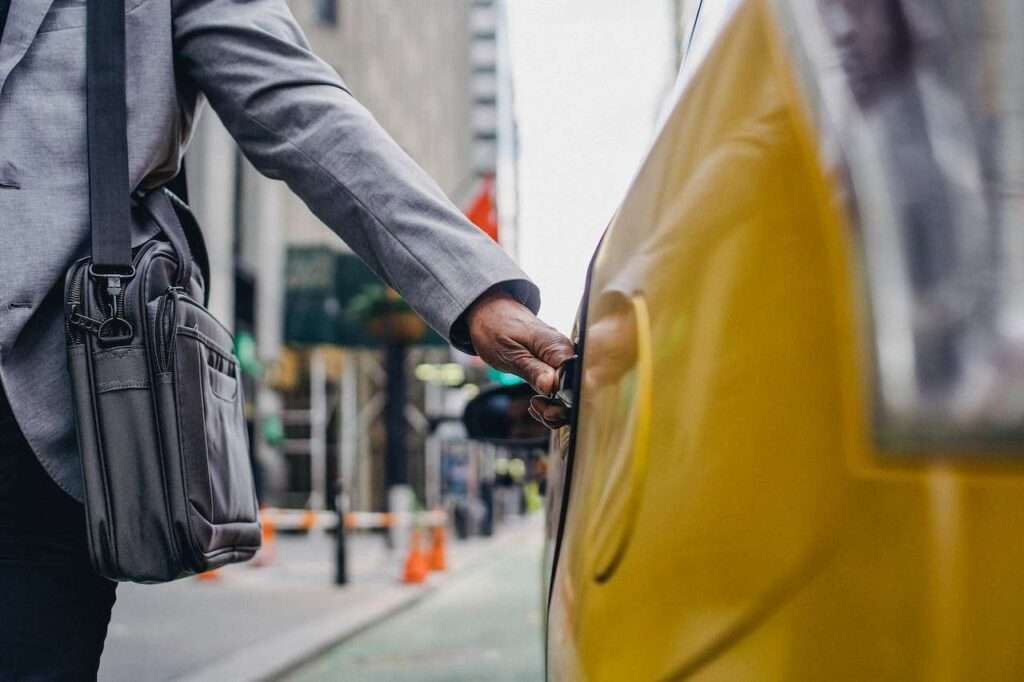Table of Contents
I. Introduction
Many people are curious about taxi rates in New York, New York City, often referred to as the “City That Never Sleeps,” is a vibrant metropolis teeming with life and opportunities. As a melting pot of cultures and a center of commerce, millions of residents and tourists traverse its streets daily, relying on a vast transportation network to get around. Among the myriad options, the iconic yellow taxis stand out as a quintessential part of the city’s fabric, offering convenience, accessibility, and a touch of nostalgia.
A. Importance of Knowing Taxi Rates in New York
For both locals and visitors, having a solid understanding of taxi rates in New York is an essential aspect of navigating the city efficiently. Time is of the essence in this bustling urban landscape, and knowing how much a taxi ride costs can help individuals plan their journeys more effectively. Whether it’s commuting to work, exploring the city’s attractions, or getting to that crucial business meeting on time, being aware of the fares can save both time and money.
Moreover, New York City’s taxi system is known for its complexity in fare calculation. The rates can vary based on multiple factors, such as time of day, route taken, and additional surcharges. Without proper knowledge, passengers might be caught off guard by unexpected expenses. Understanding taxi rates in New York empowers individuals to make informed decisions about transportation options, ensuring a smooth and predictable travel experience.
B. Overview of the NYC Taxi System
The taxi rates in New York and NYC Taxi System are an integral part of the city’s identity, serving as a lifeline for millions of people every day. Yellow taxis, easily recognizable by their iconic color and rooftop medallions, are scattered throughout the city, ready to pick up passengers at a moment’s notice. Taxi drivers are the unsung heroes, navigating the chaotic streets, and ensuring people reach their destinations safely and swiftly.
The Taxi and Limousine Commission (TLC) oversees and regulates the taxi industry, setting standards, issuing licenses, and monitoring driver behavior. The fleet of yellow cabs is diverse, encompassing various vehicle models that adhere to the city’s stringent safety and emission standards.
C. Purpose and Scope of the Article
The purpose of this comprehensive guide is to provide readers with in-depth knowledge about taxi rates in New York City. From fare structures to factors influencing fares, and from understanding zone-based calculations to tips for optimizing taxi rides, this article aims to be the ultimate resource for taxi passengers.
Throughout the article, we will explore the intricacies of the taxi rates in New York and the NYC taxi fare system, breaking down each component to demystify the fare calculation process. We will also delve into various factors that can affect taxi fares, including peak hours, weather conditions, and special events, to help passengers anticipate potential fare fluctuations.
Additionally, we will compare taxi rates in New York with other transportation options, providing a clear perspective on when taxis might be the most cost-effective choice. Safety and etiquette in taxis will also be emphasized, ensuring that passengers can travel with peace of mind and respect for drivers.
Moreover, we will address common questions and concerns that passengers might have about NYC taxi rates, providing clarity and transparency on tipping practices, fare disputes, and other related topics.
By the end of this article, readers will have gained a comprehensive understanding of New York City’s taxi rates, enabling them to embark on their journeys with confidence and a better appreciation for the iconic yellow cabs that roam the bustling streets of the city that never sleeps.
II. Understanding NYC Taxi Fare Structure
taxi rates in New York structure is a multi-tiered system that incorporates various components to determine the final fare for a taxi ride. As passengers embark on their journeys, it is crucial to grasp the intricacies of this fare system to make informed decisions and avoid any surprises at the end of their rides. In this section, we will explore each element of the NYC taxi fare structure in detail.
A. Base Fare and Mileage Charges
The taxi fare begins with a base fare, which is the initial cost charged to passengers as soon as they enter the cab. The base fare covers the first fraction of the journey, usually a set distance or time. In New York City, taxi rates in New York, the base fare is determined by the Taxi and Limousine Commission (TLC) and is subject to periodic review and adjustment.
In addition to the base fare, taxis charge a mileage fee for the distance traveled during the ride. The mileage charge varies depending on the time of day and is higher during peak hours. It is essential to note that mileage charges are calculated based on the “garage-to-garage” principle, which includes the distance the driver has to travel to pick up a passenger and return to their starting point after dropping off the passenger.
B. Waiting Time Charges
Taxi rates in New York depend on waiting time charges coming into play when the taxi is stationary or moving at a very slow pace due to traffic congestion or other delays. The waiting time is calculated based on a set rate per minute, which encourages drivers to keep the ride efficient. Waiting time charges are an integral part of the fare structure, especially in a city as bustling as New York, where traffic jams are a common occurrence.
C. Peak Hour and Night Surcharge
To incentivize drivers to be on the road during peak demand times and late hours, the taxi fare structure includes peak hour and night surcharges. During designated peak hours, such as rush hour or during special events, an additional amount is added to the fare to account for increased demand and potential delays.
Similarly, a night surcharge is imposed during nighttime hours when taxis are in higher demand due to limited public transportation options. This surcharge contributes to the additional costs drivers may incur during late-night trips.
D. Toll and Surcharges
Tolls are an important consideration in New York City, given its numerous bridges and tunnels. If the taxi route includes any toll crossings, the passenger is responsible for covering the toll charges. The toll amount is added to the final fare and is reflected on the receipt provided by the driver.
In addition to tolls, there may be other surcharges imposed during specific circumstances, such as trips to or from airports or certain neighborhoods. These surcharges are implemented to account for factors like distance traveled or the driver’s return trip to the city center after dropping off a passenger in the outskirts.
E. Additional Passenger Fees
New York City taxis are known for their convenience in accommodating multiple passengers. However, for each additional passenger beyond the initial passenger, an extra fee is charged. This fee applies regardless of the number of additional passengers and ensures that the fare appropriately reflects the number of individuals in the taxi.
F. Payment Options Accepted
To keep up with modern trends and provide convenience to passengers, New York City taxis accept various payment options. Cash remains a widely accepted method of payment, but the vast majority of taxis now also offer credit and debit card payment facilities. Contactless payment methods, such as Apple Pay and Google Pay, have also become increasingly popular, offering passengers a seamless and secure way to pay for their rides.
It is essential for passengers to verify with the taxi driver at the beginning of the ride which payment methods are available to avoid any misunderstandings when it comes time to settle the fare.
By understanding the different components of the NYC taxi fare structure, passengers can better anticipate and budget for their taxi rides. Being aware of how the fare is calculated, including base fares, mileage charges, waiting time fees, peak hour and night surcharges, tolls, and additional passenger fees, empowers passengers to make informed choices and have a smooth and transparent taxi experience in the bustling streets of New York City.
III. Factors Affecting Taxi Fares
New York City is a dynamic and ever-changing urban landscape, and several factors influence the fares charged by taxis as they navigate its busy streets. Being aware of these factors can help passengers understand the potential fluctuations in taxi fares and plan their journeys more efficiently. In this section, we will explore the key elements that affect taxi rates in New York City.
A. Time of Day and Day of the Week
The time of day and the day of the week play a significant role in determining taxi fares in New York City. During peak hours, which typically coincide with rush hours in the morning and evening, demand for taxis surges due to commuters traveling to and from work. As a result, taxi fares may be subject to a peak hour surcharge, which adds an additional amount to the total fare.
Conversely, during off-peak hours, such as late at night or early in the morning, when taxi demand is relatively low, fares may be lower due to decreased competition for rides. Traveling during off-peak hours can be a cost-effective option for passengers looking to save on their taxi expenses.
Furthermore, the day of the week can also impact taxi rates in New York. Weekends and holidays often see increased demand for taxis as people go out for leisure activities or travel to events. As a result, fares may be higher during these times, especially during festive seasons and major holidays.
B. Traffic Congestion and Route Choice
New York City is renowned for its bustling traffic, especially in the heart of Manhattan. Traffic congestion can significantly impact the duration of a taxi ride, resulting in higher waiting time charges and increased mileage fees. The slow progress of a taxi stuck in traffic can quickly add up to a higher fare, especially during peak hours when traffic congestion is more prevalent.
Additionally, the route choice made by the taxi driver can also influence the fare. While taxi drivers typically choose the most efficient route, passengers may request alternative routes to avoid specific areas or enjoy scenic drives. Taking a longer route may increase the mileage charges, and it’s essential for passengers to communicate their preferences clearly to the driver.
C. Special Events and Holidays
taxi rates in New York are also affected by special events and holidays are occasions when taxi demand can skyrocket. During events like concerts, sports games, parades, or major conventions, large crowds may flood the city, resulting in heightened demand for transportation services, including taxis. In response, the fare structure may incorporate event-related surcharges to account for the increased demand and potential traffic delays.
Similarly, during major holidays like New Year’s Eve or Thanksgiving, when people travel to celebrate with friends and family, taxi rates in New York demand can surge, leading to higher fares. Passengers should anticipate the possibility of event-related surcharges and consider alternative transportation options if they wish to avoid peak fares.
D. Weather Conditions
Weather conditions can have a significant impact on taxi rates in New York, taxi demand, and availability. During severe weather events, such as heavy rain, snowstorms, or extreme heat, people may be more inclined to opt for taxis instead of walking or using other transportation modes. As a result, taxi demand can spike, leading to higher fares, especially during the peak hours of inclement weather.
Moreover, extreme weather conditions can also affect traffic flow and cause delays on the roads, further influencing the fare calculation by increasing waiting time charges. Passengers should be aware of potential weather-related fare fluctuations and plan accordingly during adverse weather conditions.
Understanding the factors that affect taxi rates in New York City empowers passengers to make informed decisions about their transportation choices. By considering the time of day, day of the week, traffic congestion, route choice, special events, holidays, and weather conditions, passengers can anticipate potential fare variations and plan their trips more effectively. Whether it’s a daily commute or a special occasion, being knowledgeable about these fare-affecting factors can lead to a smoother and more predictable taxi experience in the bustling city of New York.
IV. Comparing Taxi Rates to Other Transportation Options
New York City offers a diverse array of transportation options to its residents and visitors, catering to different preferences and budgets. When considering travel within the city, it is essential to compare taxi rates in New York with other available modes of transportation to make the most cost-effective choice. In this section, we will compare taxi rates in New York to other popular transportation options in New York City.
A. NYC Subway and Bus Fares
The New York City subway and bus system is an extensive and well-connected public transportation network, offering affordable and efficient travel options throughout the five boroughs. The Metropolitan Transportation Authority (MTA) oversees the subway and bus services, and its fare structure is designed to accommodate various travel needs.
As of the last update, the base fare for a single subway or bus ride was set at a lower cost compared to taxi rates in New York. The MTA offers various fare options, including unlimited weekly and monthly passes, which can be a cost-effective choice for daily commuters.
One of the key advantages of using the subway and buses is the fixed fare, regardless of traffic conditions or the number of passengers. This predictability makes the MTA an attractive option for budget-conscious individuals and those looking for a straightforward payment system.
However, the trade-off for lower fares on public transportation is that travel times may be longer, especially for destinations without direct subway connections. Additionally, crowded conditions during peak hours and the lack of door-to-door service can be less convenient for some travelers.
B. Ride-Sharing Services Pricing
Ride-sharing services, also known as Transportation Network Companies (TNCs), have gained immense popularity in recent years, revolutionizing urban transportation. Companies such as Uber and Lyft provide on-demand ride services through mobile applications, connecting passengers with private drivers using their personal vehicles.
Ride-sharing fares are calculated based on factors like distance traveled, time spent on the ride, and demand at the time of booking. The dynamic pricing model means that fares can fluctuate during peak hours, special events, or adverse weather conditions when demand is high.
In certain situations, ride-sharing services may offer lower fares compared to taxi rates in New York, especially during off-peak hours or when discounts and promotions are available. However, during surge pricing periods, the fares can be significantly higher than taxi rates, catching some passengers off guard.
Ride-sharing services do provide the convenience of door-to-door service and real-time tracking of drivers. They are particularly popular among younger generations and those who prefer cashless transactions and the ability to rate drivers based on their experience.
C. Private Car Services vs. Yellow Taxis
Apart from traditional yellow taxis, private car services also operate in New York City. These car services offer pre-arranged rides, and customers can book them in advance through phone calls or mobile apps. Private car services are often associated with luxury vehicles and professional drivers.
One of the main distinctions between private car services and yellow taxis is the pricing structure. Private car services generally charge flat rates for specific destinations, which can be advantageous for passengers traveling long distances or to airports. The flat rate ensures that passengers know the cost of the ride upfront, regardless of traffic conditions.
On the other hand, yellow taxi rates in New York charge based on the distance traveled and waiting time, which can be more cost-effective for shorter distances or during less congested periods.
Both yellow taxis and private car services offer door-to-door service, providing passengers with convenience and flexibility. The choice between the two often comes down to personal preferences, budget considerations, and the need for advanced booking.
In summary, the choice between taxi services and other transportation options in New York City depends on various factors. For cost-conscious travelers on short trips, the NYC subway and buses can offer an economical and efficient solution. Ride-sharing services can be a viable alternative, providing the convenience of on-demand service, especially during off-peak hours. Private car services are a great option for those seeking luxury and predictable pricing, especially for longer journeys or airport transfers.
Each mode of transportation has its merits and suits different travel scenarios. By considering factors like travel distance, time of day, budget, and personal preferences, passengers can make informed decisions about the best transportation option for their specific needs in the vibrant and diverse city of taxi rates in New York.
V. Understanding Taxi Zones and Fare Calculation
The taxi zone system in New York City is a unique and efficient method of calculating taxi rates in New York for taxi rides. Understanding how this system works can help passengers estimate their fares more accurately and plan their journeys effectively. In this section, we will explore the taxi zone system, the fare calculation process based on zones, and the availability of interactive fare estimators and apps.
A. Overview of the Taxi Zone System
Rather than employing a traditional meter-based fare calculation, New York City taxis operate on a zone-based fare system. The city is divided into a grid of designated taxi zones, each identified by a unique number. These zones cover all five boroughs of New York City, providing comprehensive coverage of the entire urban area.
The Taxi and Limousine Commission (TLC) oversees the zoning system and updates the boundaries periodically to accommodate changes in city infrastructure and transportation patterns. Each taxi is equipped with a zone map, ensuring that drivers can accurately determine the zone in which a passenger’s pickup and drop-off points fall.
The taxi zone system offers several advantages, including:
- Predictable Fares: With a zone-based system, passengers can have a general idea of the fare based on the number of zones traveled rather than constantly monitoring an ever-changing meter.
- Transparent Pricing: By using a fixed zone-to-zone fare structure, passengers can easily verify that they are charged correctly for their taxi rides.
- Simplified Fare Disputes: The zone-based system reduces the likelihood of fare disputes between drivers and passengers, as the fare is determined by the number of zones crossed.
B. How Fare is Calculated Based on Zones

taxi rates in New York calculation in the New York City taxi zone system is a straightforward process. When a passenger boards a taxi, the driver inputs the pickup zone number into the taxi’s meter. As the taxi progresses on the journey, the meter continuously tracks the zones traversed.
taxi rates in New York calculation are based on two main factors: the number of zones crossed and any applicable surcharges. As the taxi moves from one zone to another, the meter increments the fare based on the predetermined rate per zone set by the TLC.
The total fare is the sum of the zone-to-zone charges and any additional surcharges that may apply. These surcharges can include peak hour surcharges, night surcharges, and event-related surcharges. If the route includes toll crossings, the toll amount is added to the fare as well.
The driver’s responsibility is to ensure the accurate recording of the zones crossed and the appropriate surcharges, while passengers can monitor the fare progress displayed on the meter during the ride.
C. Interactive Fare Estimators and Apps
To make fare estimation more accessible and convenient for passengers, various interactive fare estimators and apps are available. These tools allow passengers to estimate the approximate fare for their intended taxi ride before starting their journey.
Interactive fare estimators typically require users to input the pickup and drop-off addresses or the zone numbers. The tool then calculates the expected fare based on the zone-to-zone charges and any additional surcharges.
In recent years, ride-hailing apps and taxi dispatch services have incorporated fare estimation features, enabling passengers to get fare estimates directly within the app. This integration allows users to compare fares between different transportation options, such as taxis and ride-sharing services, before making their decision.
Having access to fare estimators and apps empowers passengers to budget for their taxi rides and make informed choices about their transportation options. By utilizing these tools, passengers can plan their journeys with confidence, knowing the approximate cost of their taxi ride in advance for affordable taxi rates in New York.
In conclusion, the New York City taxi zone system offers a transparent and predictable fare calculation process, allowing passengers to understand the fare based on the zones traveled. With the help of interactive fare estimators and apps, passengers can plan their taxi journeys more efficiently and have a better understanding of the costs associated with traveling through the diverse and bustling neighborhoods of New York City.
VI. Tips for Saving Money on Taxi Rides
Taxi rides in New York City can be a convenient and efficient way to get around the city, but fares can add up quickly, especially during peak hours or in heavy traffic. However, with some smart strategies and a bit of planning, passengers can save money on their taxi rides without compromising on convenience. In this section, we will explore several tips for saving money on taxi rides in the bustling streets of New York City for affordable taxi rates in New York.
A. Navigating Efficient Routes
One of the most effective ways to save money on taxi rides is by navigating efficient routes for affordable taxi rates in New York. New York City streets can be notoriously congested, leading to longer travel times and higher fare charges. Passengers can save both time and money by planning routes that avoid known traffic hotspots and utilizing streets with smoother traffic flow.
Communicating preferred routes to the taxi driver at the beginning of the ride can also be beneficial. Experienced drivers often have alternative routes up their sleeves, and some may appreciate passengers who actively engage in route selection.
Additionally, consider using navigation apps or maps to follow the taxi’s route in real time. This allows passengers to ensure that the driver is taking an optimal route and staying on track with taxi rates in New York.
B. Utilizing Shared Rides
Sharing a taxi ride with fellow passengers is an excellent way to cut down on transportation expenses, particularly for solo travelers or small groups. Many taxis in New York City offer shared ride options, where multiple passengers heading in similar directions can share a single taxi. This not only divides the fare among passengers but also helps reduce the number of vehicles on the road, contributing to a greener environment.
Some ride-hailing apps also provide ride-sharing features that connect passengers with others traveling in the same direction. Passengers can opt for shared rides, and the app will match them with compatible co-passengers to split the fare.
However, it’s important to keep in mind that shared rides may take slightly longer due to additional pickups and drop-offs along the way. For those not in a rush, shared rides are a cost-effective and eco-friendly option.
C. Avoiding Peak Hour Surcharges
Avoiding peak hours whenever possible is a simple yet impactful way to save money on taxi rides for affordable taxi rates in New York. As mentioned earlier, during peak hours, taxi fares may include surcharges due to increased demand and traffic congestion. By planning trips during off-peak hours, passengers can enjoy lower fares and a more relaxed travel experience.
Peak hours in New York City typically coincide with morning and evening rush hours on weekdays. Passengers can plan their travel to avoid these times or consider flexible work schedules to travel during less congested periods for affordable taxi rates in New York.
Additionally, peak hour surcharges may apply during special events or holidays when taxi demand is high. Being aware of such surcharge periods and planning alternative travel times can lead to significant fare savings.
D. Understanding Split Fare Options
For groups traveling together, splitting the fare can be an effective way to reduce individual costs. New York City taxis offer the option to split the fare among multiple passengers, making it easier for everyone to pay their share of the cost for the best taxi rates in New York.
When using a ride-hailing app, passengers can take advantage of the built-in split fare feature, which simplifies the process. The app will divide the fare evenly among the specified number of passengers, allowing each individual to pay their portion directly through the app.
For those paying with cash, passengers can coordinate with their fellow riders to ensure each person contributes the appropriate amount. Effective communication and planning are essential to avoid confusion and ensure a smooth fare-splitting process.
Furthermore, to get affordable taxi rates in New York, passengers should be aware that some taxi drivers may charge a small additional fee for processing split payments, so it’s advisable to clarify this with the driver at the beginning of the ride.
In conclusion, saving money on taxi rides in New York City is possible with some strategic planning and mindful choices. Navigating efficient routes, utilizing shared rides, avoiding peak hour surcharges, and understanding split fare options can all contribute to more budget-friendly taxi experiences. By adopting these money-saving tips, passengers can enjoy the convenience of taxis while keeping their transportation costs in check in the bustling and vibrant streets of the Big Apple.
VII. Safety and Etiquette in NYC Taxis
When hailing a yellow taxi in New York City, besides the affordable taxi rates in New York, safety and proper etiquette should be a top priority for both passengers and drivers. Navigating the busy streets of the Big Apple requires cooperation and mutual respect to ensure a smooth and secure taxi experience. In this section, we will explore essential safety guidelines and etiquette for passengers and drivers in NYC taxis.
A. Choosing Licensed Taxis
Ensuring the safety of passengers starts with choosing a licensed and authorized taxi. In New York City, licensed taxis have distinctive features that set them apart from unlicensed or illegal vehicles. Passengers should look for the following indications to identify licensed taxis:
- Yellow Color and Medallion Number: Official New York City taxis are painted yellow and display a medallion number on the hood, indicating their licensing.
- Top Light: Licensed taxis have a top light with the word “TAXI” illuminated when the cab is available for service.
- Driver Information: The driver’s information, including a photo and license, should be prominently displayed within the taxi.
- Rate Card: A rate card showing the fare structure should be visible for passengers to review.
Passengers should avoid accepting rides from unmarked vehicles or individuals offering taxi services on the street. These unlicensed vehicles might not adhere to proper safety regulations and could pose potential risks to passengers.
B. Identifying Legitimate Drivers
For passengers’ safety, it is crucial to ensure that the driver operating the taxi is legitimate and authorized by the Taxi and Limousine Commission (TLC). Passengers can follow these steps to verify the driver’s authenticity:
- Driver Information: As mentioned earlier, the driver’s photo and license should be displayed within the taxi. Passengers can glance at this information to confirm the driver’s identity.
- TLC License Sticker: The driver should have a TLC license sticker affixed to the inside of the windshield. This sticker confirms the driver’s compliance with TLC regulations.
- Identification Requests: Passengers have the right to ask the driver to verify their identification if they have any doubts. A genuine driver will not hesitate to comply with this request.
By confirming the driver’s authenticity, passengers can have peace of mind and be confident in their safety during the taxi ride.
C. Securing Seat Belts and Child Seats
Safety should always be a priority for passengers during taxi rides, as well as affordable taxi rates in New York, and that includes ensuring the use of seat belts at all times. Passengers should fasten their seat belts before the taxi starts moving and keep them on throughout the journey. Taxi drivers are required to inform passengers about the importance of wearing seat belts and should not proceed until all passengers have buckled up.
For passengers traveling with children, it is essential to use appropriate child seats or boosters for their safety. New York State law requires children under the age of 8 to be secured in an appropriate child restraint system while riding in a taxi. Passengers should plan ahead and bring their child seats when necessary or inquire if the taxi company provides child seat services.
D. Appropriate Behavior and Respectful Communication
Maintaining appropriate behavior and respectful communication is crucial for a pleasant and safe taxi experience. Passengers and drivers should treat each other with respect and courtesy, fostering a positive and respectful environment within the taxi.
For passengers, being polite and considerate to the driver, fellow passengers, and other road users enhances the overall taxi journey. Avoiding loud or offensive language and refraining from engaging in distracting activities that might interfere with the driver’s concentration is essential for everyone’s safety.
Similarly, drivers should be courteous to passengers and provide assistance when needed, such as helping passengers with their luggage. Maintaining a calm and professional demeanor while driving is crucial for passenger comfort and safety.
In the event of a disagreement or issue during the ride, both passengers and drivers should handle the situation calmly and respectfully. Passengers have the right to voice concerns about the route or any issues related to the fare, while drivers should address these concerns professionally and honestly.
Conclusion:
Safety and etiquette are fundamental aspects of the taxi experience in New York City. By choosing licensed taxis, identifying legitimate drivers, securing seat belts and child seats, and practicing appropriate behavior and respectful communication, both passengers and drivers can contribute to a secure and pleasant taxi journey.
Besides the affordable taxi rates in New York, when passengers prioritize their safety by choosing licensed taxis and using seat belts, and drivers adhere to TLC regulations and ensure passenger comfort, everyone can enjoy a smooth and secure ride through the bustling streets of the Big Apple. By respecting each other’s rights and responsibilities, passengers and drivers foster a positive and respectful taxi environment, making the taxi ride an enjoyable and memorable part of the New York City experience.
VIII. Understanding Taxi Fare Rules and Policies
New York City’s taxi system operates under a set of rules and policies designed to protect the rights of both passengers and drivers. Understanding these taxi rates in New York rules and policies is essential for passengers to ensure a fair and transparent taxi experience. In this section, we will explore taxi fare complaint procedures, refunds and overcharge claims, rules for luggage and extra charges, and the Taxi Passenger Bill of Rights.
A. Taxi Fare Complaint Procedures
In the event of a fare dispute or any issues related to the taxi ride, passengers have the right to file a complaint with the Taxi and Limousine Commission (TLC). The TLC is responsible for regulating and overseeing the taxi industry in New York City, and it takes passenger complaints seriously.
To file a complaint, passengers can use one of the following methods:
- 311: Passengers can call 311, the city’s non-emergency helpline, to report complaints or issues related to taxi fares or driver behavior.
- TLC Website: The TLC has an official website where passengers can submit complaints online. The website provides a simple and user-friendly platform for filing complaints and detailing the nature of the issue.
- Mobile App: Some ride-hailing apps and taxi dispatch services allow passengers to report complaints directly through their mobile apps. These apps often have built-in customer support features to handle fare disputes and other issues.
When filing a complaint, passengers should provide as much detail as possible, including the date and time of the ride, the taxi’s medallion number, and a clear description of the problem. The TLC will investigate the complaint and take appropriate action, which may include issuing fines or sanctions to drivers found in violation of fare rules.
B. Refunds and Overcharge Claims
In cases where passengers believe they have been overcharged or have experienced billing errors during a taxi ride, they have the right to request a refund or lodge an overcharge claim. The TLC oversees and processes these claims to ensure that passengers are not unfairly charged for their taxi journeys to get the best taxi rates in New York.
To request a refund or submit an overcharge claim, passengers can follow these steps:
- Collect Receipts: Passengers should retain their taxi receipts as proof of payment and to validate the fare charged.
- Document the Issue: Passengers should document the specific issue or discrepancy they are experiencing with the fare or the billing.
- Contact the TLC: Passengers can contact the TLC through the methods mentioned in the “Taxi Fare Complaint Procedures” section to report the overcharge or request a refund.
The TLC will investigate the claim and may ask for additional information or evidence to verify the validity of the claim. If the claim is found to be valid, the TLC will ensure that the appropriate refund is issued to the passenger.
C. Rules for Luggage and Extra Charges
New York City taxi drivers are required to comply with rules regarding luggage handling and extra charges. Passengers should be aware of these rules to avoid any misunderstandings during their taxi rides.
- Luggage Handling: Taxi drivers are required to assist passengers with loading and unloading their luggage into the trunk of the taxi. Drivers should handle luggage with care and ensure that it is safely secured.
- Extra Charges: The standard taxi fare includes the transportation of luggage within the trunk or on the roof of the taxi. Drivers are not allowed to charge additional fees for handling luggage within these limits.
- Oversized or Excessive Luggage: Passengers with oversized or excessive luggage that cannot fit in the trunk may be subject to an additional fee. The TLC sets guidelines for such charges, and drivers should inform passengers in advance about any extra fees for oversized luggage.
D. Taxi Passenger Bill of Rights
To further protect the rights of taxi passengers, the TLC has established the Taxi Passenger Bill of Rights. This document outlines the rights and responsibilities of both passengers and drivers and aims to promote a safe, respectful, and fair taxi experience.
The Taxi Passenger Bill of Rights includes the following key points:
- Right to a Safe and Comfortable Ride: Passengers have the right to expect a safe and comfortable ride in a licensed taxi.
- Right to Knowledgeable Drivers: Passengers have the right to drivers who are knowledgeable about New York City and familiar with the city’s streets and neighborhoods.
- Right to a Clean Vehicle: Passengers have the right to expect a clean and well-maintained taxi for their ride.
- Right to Air Conditioning and Heat: Passengers have the right to request appropriate air conditioning or heat during their ride, depending on weather conditions.
- Right to Refuse Multiple Share Rides: Passengers have the right to refuse to share a ride with other passengers.
- Right to Choose the Route: Passengers have the right to request a specific route or to avoid tolls if they wish.
- Right to Request a Receipt: Passengers have the right to request a printed receipt for their ride.
The Taxi Passenger Bill of Rights serves as a guideline for both passengers and drivers to ensure a positive and respectful taxi experience.
Conclusion:
Understanding taxi rates in New York rules and policies is essential for passengers to protect their rights and make informed decisions during taxi rides. By being aware of complaint procedures, knowing how to request refunds or report overcharge claims, understanding rules for luggage and extra charges, and being familiar with the Taxi Passenger Bill of Rights, passengers can confidently navigate the New York City taxi system.
Compliance with these fare rules and policies by both passengers and drivers promotes a fair, transparent, and respectful taxi experience for everyone involved. The TLC plays a vital role in overseeing and enforcing these rules, ensuring that passengers receive the quality service they deserve while traveling through the bustling streets of New York City while having the best taxi rates in New York.
IX. Tips for Tipping Taxi Drivers
Tipping taxi drivers is a customary practice in New York City, and it is an essential way to show appreciation for their service and hard work. Proper tipping not only acknowledges the driver’s efforts but also encourages professionalism and quality service within the taxi industry. In this section, we will explore tips for tipping taxi drivers, including standard tipping etiquette, factors to consider for generous tips, and situations warranting reduced tips.
A. Standard Tipping Etiquette
The standard tipping etiquette for taxi drivers in New York City is typically around 15% to 20% of the total fare. This range provides a fair gratuity for drivers while also considering the quality of service received. However, passengers may choose to adjust the tip based on their overall experience during the ride.
When calculating the tip, passengers can round up the fare to the nearest dollar amount or apply a percentage based on the total fare. For example, if the fare is $12.50, a standard 15% tip would be approximately $1.87, which can be rounded up to $2.
It is essential to consider the driver’s effort, professionalism, and attentiveness when determining the appropriate tip amount. A courteous and skilled driver who goes above and beyond to make the ride enjoyable and safe deserves recognition with a generous tip.
B. Factors to Consider for Generous Tips
Certain factors may warrant a more generous tip for taxi drivers. Passengers can consider the following situations when deciding on a higher gratuity:
- Knowledge of Routes: If the driver displays excellent knowledge of the city’s streets and efficiently navigates through traffic, passengers may choose to tip more generously as this enhances the overall ride experience.
- Assistance with Luggage: Drivers who assist with handling luggage and ensuring it is safely loaded and unloaded from the taxi deserve recognition with a generous tip.
- Professionalism and Courtesy: Drivers who maintain a professional and courteous demeanor throughout the ride, providing a comfortable and pleasant environment, may be rewarded with a more substantial tip.
- Exemplary Service: If the driver goes above and beyond to provide exceptional service, such as offering local recommendations or ensuring the passenger’s needs are met, passengers may show appreciation with a more generous tip.
- Inclement Weather or Difficult Conditions: During adverse weather conditions or challenging traffic situations, a generous tip can acknowledge the driver’s efforts to navigate safely through the conditions.
C. Situations Warranting Reduced Tips
While the standard practice is to tip taxi drivers, certain situations may warrant a reduced tip or no tip at all. Passengers can consider the following scenarios when determining the tip amount:
- Poor Driving Behavior: If the driver displays reckless or unsafe driving behavior, passengers may feel inclined to reduce the tip or report the incident to the Taxi and Limousine Commission.
- Rudeness or Disrespect: Drivers who exhibit rude or disrespectful behavior towards passengers may not receive a customary tip, as this behavior is not conducive to a positive taxi experience.
- Failure to Assist: If the driver refuses to provide reasonable assistance with luggage or does not adhere to basic customer service expectations, passengers may consider a reduced tip.
- Inadequate Cleanliness: A taxi that is not clean and well-maintained may affect the overall experience, potentially warranting a slightly reduced tip.
It is essential to note that reducing or withholding a tip should be done thoughtfully and as a response to a significant issue with the service received. If passengers encounter severe issues with the taxi ride, they should consider filing a complaint with the Taxi and Limousine Commission to address the matter appropriately.
Conclusion:
Tipping taxi drivers in New York City is an important practice to acknowledge and reward their hard work and professionalism. Standard tipping etiquette typically ranges from 15% to 20% of the total fare, with passengers having the option to adjust the tip based on their overall experience.
Generous tips may be warranted for drivers who demonstrate exceptional service, knowledge of routes, assistance with luggage, professionalism, and courtesy. On the other hand, reduced tips may be considered in situations where drivers display poor behavior, inadequately assist passengers, or provide an unsatisfactory experience.
By practicing appropriate tipping and recognizing exceptional service, passengers contribute to a positive and respectful taxi environment while expressing appreciation for the vital role taxi drivers play in the bustling streets of New York City.
X. Frequently Asked Questions (FAQs)
A. What are the Current Taxi Rates in NYC?
As of the latest update, the standard taxi rates in New York is as follows: Initial Charge : $2.50 Per Mile Charge : $2.80 Per Minute Charge (while the taxi is moving) : $0.50 Per Minute Charge (while the taxi is at a standstill or in slow traffic) : $0.50 Night Surcharge (8:00 PM to 6:00 AM) : $0.50 Peak Hour Surcharge (Weekdays, 4:00 PM to 8:00 PM) : $1.00 NY State Congestion Surcharge : $2.75 (applicable in Manhattan south of 96th Street) Please note that taxi rates in New York may be subject to change, so it is advisable to check with the Taxi and Limousine Commission (TLC) or official sources for the most up-to-date information.
B. How Much Does a Typical Ride from JFK Airport to Manhattan Cost?
Based on taxi rates in New York, the fare from John F. Kennedy International Airport (JFK) to Manhattan is subject to the standard taxi rates, as well as any applicable surcharges and tolls. On average, a taxi ride from JFK Airport to Manhattan can cost between $50 to $70, excluding tips and tolls. It is important to keep in mind that travel times and taxi rates in New York may vary depending on traffic conditions and the specific destination within Manhattan.
C. Are Tips Included in the Fare?
No, tips are not included in the fare displayed on the taxi meter. Tipping is a customary practice in taxi rates in New York, and passengers are expected to provide a gratuity to the taxi driver as a show of appreciation for their service.
D. Do Taxis Accept Credit Cards?
Yes, most taxis in New York City accept credit cards as a form of payment. Passengers have the option to pay with cash or credit/debit cards for their taxi rides. It is advisable to inform the driver about the preferred payment method at the beginning of the ride.
E. How Can I File a Complaint Against a Taxi Driver?
To file a complaint against a taxi driver in New York City, passengers can follow these steps: Gather Information : Collect relevant details, such as the taxi medallion number, the date and time of the ride, and a description of the issue. Contact TLC : Passengers can file a complaint with the Taxi and Limousine Commission (TLC) through their website, or official app, or by calling 311. Provide Details : When submitting the complaint, provide a clear and detailed description of the incident, along with any supporting evidence, such as photos or receipts. The TLC will investigate the complaint and take appropriate action, if necessary, to address the issue.
F. Are Taxis Safe for Solo Travelers, Especially at Night?
Yes, taxis are generally considered safe for solo travelers, including during nighttime hours. Licensed taxis in New York City undergo regular safety checks, and drivers are vetted by the TLC. However, as with any form of transportation, it is advisable for solo travelers to remain vigilant, especially when traveling late at night. Passengers can choose well-lit and populated areas for pickup and drop-off points and share their trip details with friends or family.
G. Can I Request a Specific Route for the Driver to Take?
Yes, passengers can request a specific route for the driver to take. New York City taxi passengers have the right to request a preferred route, as long as it is a legal and reasonable choice. However, drivers may consider factors such as traffic conditions and road closures when selecting the route.
H. What Happens if a Taxi Meter Malfunctions During the Ride?
If the taxi meter malfunctions during the ride, passengers should bring it to the driver’s attention immediately. The driver should either fix the issue or inform the passenger that the meter is not functioning and agree on an alternative fare arrangement. If passengers believe they have been charged incorrectly due to a malfunctioning meter, they can report the incident to the TLC.
I. Is It Customary to Tip Extra for Assisting with Luggage?
Yes, it is customary to tip extra for drivers who provide assistance with luggage, especially when they handle heavy or oversized bags. Passengers may consider adding an additional amount to the tip as a gesture of appreciation for the driver’s help.
J. Are There Any Discount Programs Available for Frequent Taxi Users?
As of the latest update for taxi rates in New York, there are no specific city-wide discount programs exclusively for frequent taxi users. However, passengers can take advantage of various ride-hailing apps and taxi dispatch services that offer loyalty programs, discounts, or promotional codes for regular customers.
Conclusion:
These frequently asked questions provide valuable information about taxi rates in New York, tipping, safety, payment options, and passenger rights in New York City. By understanding the fare rules, tipping etiquette, and complaint procedures, passengers can have a smooth and enjoyable taxi experience while exploring the vibrant and bustling streets of the Big Apple.
XI. Conclusion
A. Recap of Key Points
In this comprehensive guide, we have explored the world of taxi rates in New York City, empowering readers with the essential knowledge to navigate the bustling streets with confidence. Let us recap the key points discussed throughout the article:
- We began with the “Introduction,” highlighting the importance of knowing taxi rates in New York and providing an overview of the NYC taxi system.
- “Understanding taxi rates in New York Structure” covered the base fare, mileage charges, waiting time charges, peak hour and night surcharges, tolls, surcharges, and accepted payment options.
- “Factors Affecting taxi rates in New York” explored how the time of day, day of the week, traffic congestion, route choice, special events, and weather conditions can impact taxi fares.
- “Comparing taxi rates in New York to Other Transportation Options” delved into the fares of NYC subway and buses, ride-sharing services, and private car services, allowing readers to make informed decisions about their travel options.
- “Understanding Taxi Zones and Fare Calculation” explained the unique taxi zone system, how fares are calculated based on zones, and the availability of interactive fare estimators and apps for easy fare estimation.
- “Tips for Saving Money on Taxi Rides” provided readers with strategies to save on taxi rates in New York by navigating efficient routes, utilizing shared rides, avoiding peak hour surcharges, and understanding split fare options.
- “Safety and Etiquette in NYC Taxis” emphasized the importance of choosing licensed taxis, identifying legitimate drivers, securing seat belts and child seats, and practicing appropriate behavior and respectful communication.
- “Understanding taxi rates in New York Rules and Policies” covered complaint procedures, refunds and overcharge claims, rules for luggage and extra charges, and the Taxi Passenger Bill of Rights to ensure passengers have a smooth and fair taxi experience.
- “Tips for Tipping Taxi Drivers” discussed standard tipping etiquette, factors for generous tips, and situations warranting reduced tips, acknowledging the crucial role of drivers in providing quality service.
- Lastly, in the “Frequently Asked Questions (FAQs)” section, we addressed common queries about current taxi rates in New York, airport fares, tipping, credit card acceptance, complaint procedures, safety for solo travelers, route preferences, meter malfunctions, luggage assistance, and discount programs.
B. Empowering Readers with Taxi Fare Knowledge in NYC
The goal of this guide was to empower readers with comprehensive and accurate information about taxi rates in New York. By providing a detailed outline of the topic and answering frequently asked questions, readers now have a solid understanding of how taxi fares are calculated, how to save money on rides, and how to ensure a safe and respectful taxi experience.
Equipped with knowledge of the taxi zone system, taxi rates in New York structures, and interactive fare estimators, readers can confidently plan their taxi journeys and budget accordingly. They can also make informed comparisons between different transportation options and choose the most suitable mode of travel based on their needs.
C. Encouraging Safe and Informed Taxi Travels in New York
Furthermore, this guide encourages safe and informed taxi travels in the vibrant city of New York and taxi rates in New York. By understanding safety protocols, proper etiquette, and passenger rights, readers can contribute to a positive taxi environment that prioritizes professionalism and mutual respect.
Being aware of the Taxi Passenger Bill of Rights empowers passengers to demand quality service and fair treatment during their taxi rides. Additionally, understanding the process of filing complaints and overcharging claims ensures that passengers have recourse in case of any issues regarding the taxi rates in New York.
By tipping taxi drivers appropriately, passengers show appreciation for their hard work and encourage a high standard of service within the taxi industry. Generous tips for exemplary service and assistance with luggage acknowledge the efforts of drivers in providing a pleasant and safe journey.
In conclusion, this guide equips readers with the knowledge and confidence to navigate the intricate world of taxi rates in New York City. By embracing the tips and guidelines provided, passengers can make the most of their taxi experiences while exploring the iconic neighborhoods and landmarks of the Big Apple. Armed with fare knowledge and safety awareness, readers are now ready to embark on their taxi adventures with ease and assurance








